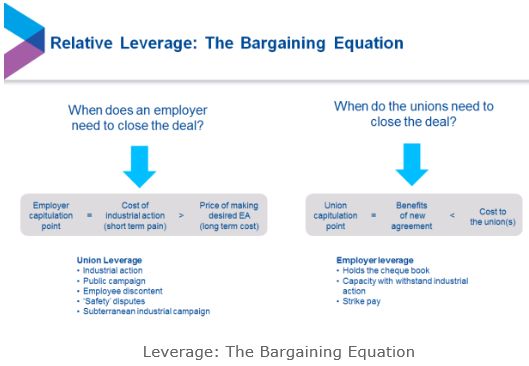Leverage in collective bargaining negotiations is so important in a regulatory framework which condones its use.
When does an employer in a collective bargaining negotiation in a tough environment typically close the deal? So often, the employer's capitulation point arises where the cost of industrial action (and any other pressure which is applied) is perceived to outweigh the cost of making the agreement. One cost reflects the need to alleviate what is short term pain, but often with longer term consequences. The other is one which whilst not felt immediately, becomes increasingly burdensome over the long term.
The cost of industrial action is often overestimated in this scenario because of its immediacy and the direct nature of its impact. There are customers to supply. There is a manufacturing line that can't be interrupted without direct cost. There is a network to run.
Conversely, the consequences of making the agreement are often underestimated. The compounding effect of wage increases. The impact on leave accruals and the balance sheet. The less tangible costs associated with impediments to change restricting a workplace to run optimally. It's easier to "overlook" these amidst the heat of the short term pain.
Equally, union negotiators have an equation. At some point, the cost to a union and its officials pressing particular claims outweighs the benefit which might follow from successfully securing them. Their members are agitated. They simply want a pay increase. They are tired of being the "meat in the sandwich" between the employer and the union(s).

Both players have leverage. I'm not here advocating aggression or confrontation. In the ideal world, there would be enough maturity in the culture and the system to see true interest-based bargaining. But this is illusory for many an employer. And so leverage cannot be ignored.
Two things arise. First, properly calibrating the short term pain with long term cost can grow leverage because walking away is more accurately viewed as causing less harm to the business than doing the deal. Secondly, you have to work hard to identify your sources of leverage in and outside of the negotiation room.
The content of this article is intended to provide a general guide to the subject matter. Specialist advice should be sought about your specific circumstances.


